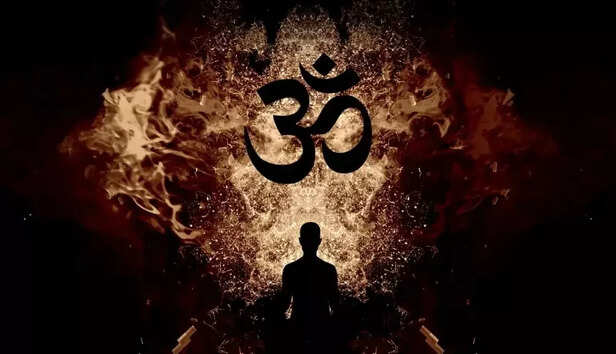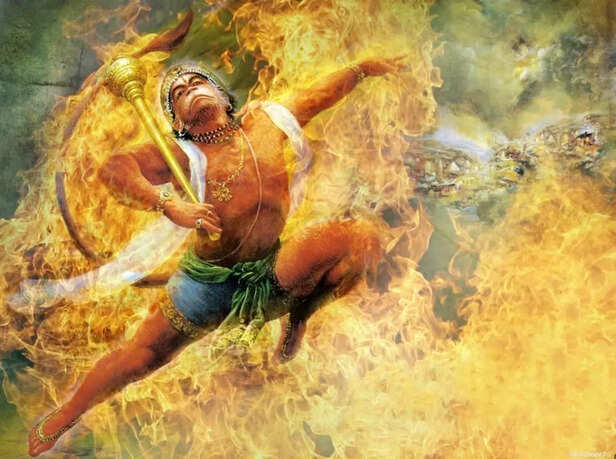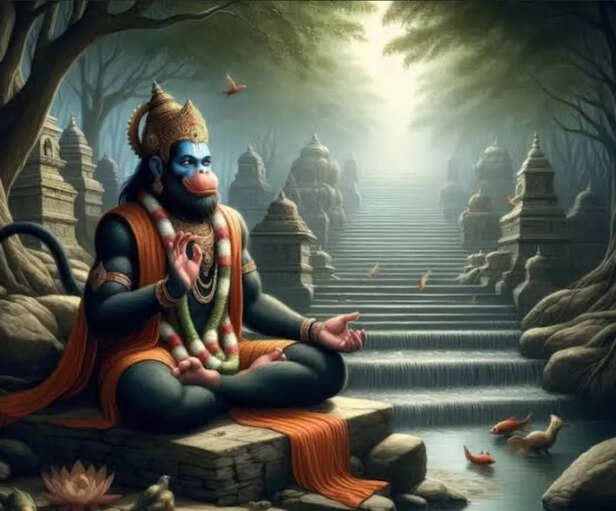Why Sundara Kānda Holds the Key to Transforming Your Life—3 Powerful Lessons from Hanuman's Journey
Ankit Gupta | May 04, 2025, 09:51 IST

In the vast expanse of the Ramayana, if there is one section that stands out not just for its narrative strength but for its transformational potential, it is the Sundara Kānda. Unlike other kāṇḍas where Shri Rama is the central figure, here the spotlight turns fully toward Hanuman — not just as a devotee, but as a living embodiment of courage, clarity, surrender, and inner strength. It’s no surprise that elders and spiritual masters often recommend reading Sundara Kānda during times of adversity. Its power lies not merely in the events it describes, but in the quiet truths it plants in your heart — truths that speak to the soul when nothing else does.
“रामं दशरथं विद्धि, मामविद्धि हनूमन्तम्। लक्ष्मणं विद्धि भरतं, शत्रुघ्नं विद्धि जामदग्निम्॥”
“Know Rama as Dasharatha, know me as Hanuman; know Lakshmana as Bharata, and Shatrughna as Parashurama.”
In the rich ocean of Itihasa that is the Ramayana, one chapter gleams with the radiant glow of inner transformation: the Sundara Kānda. Unlike the other kāṇḍas, where the narrative centers on Lord Rama’s divine journey, here the story is entrusted to Hanuman, the epitome of devotion, strength, and self-realization. His journey to Lanka becomes a metaphor for your own journey through adversity, confusion, and challenge.
For ages, saints and elders have emphasized reading Sundara Kānda during times of trial. Not merely for the events it recounts, but for the spiritual code it reveals. It is not just a tale. It is a spiritual mirror, an invitation to remember who you truly are.

Hopelessness is not sadness. It is spiritual amnesia.
When Hanuman stands on the shores of the vast ocean, entrusted with the impossible task of finding Sita in the unknown land of Lanka, he does not despair. Despite being surrounded by uncertainty, danger, and immense pressure, there is no trace of helplessness in his demeanor. He remembers who he is — the son of Vayu, born of Shiva’s aspect, empowered by Rama’s mission.
This is the first great lesson of Sundara Kānda — no matter the darkness around you, light still burns within you.
Even when captured in Ravana’s court, even when tied up and mocked, Hanuman radiates composure. Why? Because he does not internalize the adversity. He responds, but he is never reactive. He sees clearly, acts purposefully, and keeps his inner alignment intact.
In a world obsessed with “what’s wrong,” we easily accept victimhood. But Hanuman’s example tells us: faith + clarity + action = transformation.
You do not need a perfect situation. You need an awakened perspective.

Hanuman did not wait for a miracle. He became the miracle.
Before Hanuman leaps across the ocean to Lanka, he doesn’t perform rituals, wait for omens, or blame the lack of divine intervention. He stands, centers himself, chants Rama’s name — and jumps.
He doesn't pray for an easier leap. He prepares for a stronger one.
This act becomes a metaphor for our own struggles. How often do we hesitate at the edge of our challenges, waiting for external signs, astrological remedies, or "manifestation techniques" to carry us forward?
Hanuman’s journey across the sea is littered with obstacles — the mountain Mainaka, the demoness Simhika, and the illusionary Surasa. But none of them can stop him. Why?
Because his power comes from inner purity, not external validation.
Hanuman teaches: The path of Dharma is straight and steep. You can’t cheat your way to the summit.
Effort, self-trust, and authentic devotion are the real tools of progress.
In modern times, spiritual laziness is disguised as “faith.” People believe reading a mantra once or visiting a temple occasionally is enough. But Hanuman reminds us:
True devotion does not bypass struggle. It elevates you through it.
Shortcuts are tempting — but they rob you of strength. And in the end, it is inner strength that builds lasting peace.

Hanuman’s real strength did not come from muscle. It came from remembrance.
During his mission, Hanuman does not rely on weapons, rituals, or armies. He doesn’t seek external protection. He takes the Name — Rama. And that becomes his shield, his sword, and his path.
In the most terrifying moments — when surrounded by Rakshasas, when his tail is set on fire — he chants Rama’s name, and suddenly the impossible becomes effortless.
This is not blind faith. It is rooted remembrance. The power of mantra, of surrender, of Divine intimacy.
Grace is not earned.
It is invited.
And it flows freely when the heart is sincere, the mind is clear, and the will is pure.
You do not need massive rituals to touch Grace.
You need alignment, humility, and presence.
We are told to strategize, network, and plan every moment. But the deeper truth is:
Not all doors open through planning. Some only open through devotion.
And Hanuman shows us how.
Sundara Kānda is not just a chapter in the Ramayana.
It is a blueprint for inner awakening.
It mirrors your own journey —
It reminds you that:
Hanuman's journey is the soul’s journey — a movement from fear into strength, from hesitation into divine remembrance.
Why is this section called Sundara (beautiful)?
Because the beauty here is not in external events.
It is in the radiance of the awakened soul.
Everything Hanuman does is saturated with sattva — goodness, courage, clarity, and devotion. Even in destruction, he is purposeful. Even in battle, he remains aligned.
True beauty is not physical. It is spiritual alignment with purpose and purity.
That is the heart of Sundara Kānda.
Reading Sundara Kānda is not just a spiritual act.
It is an act of remembrance.
Of the courage within you.
Of the devotion buried under your daily burdens.
Of the eternal presence of Divine Grace that watches over you.
You are not a weak, helpless creature moving through a chaotic world.
You are Hanuman — powerful, pure, and divinely guided.
Let the words of Sundara Kānda wake up the sleeping strength within you.
And the next time life tests you —
Don’t panic.
Pause. Remember. Leap.
“Yatra yatra Raghunatha keertanam,
Tatra tatra krutamasta kanjalim.
Bhaspavaari paripoorna lochanam,
Marutim namata raakshasaantakam.”
"Wherever the glories of Rama are sung, there Hanuman bows with folded hands and tear-filled eyes. To that destroyer of demons, we offer our salutations."
“Know Rama as Dasharatha, know me as Hanuman; know Lakshmana as Bharata, and Shatrughna as Parashurama.”
In the rich ocean of Itihasa that is the Ramayana, one chapter gleams with the radiant glow of inner transformation: the Sundara Kānda. Unlike the other kāṇḍas, where the narrative centers on Lord Rama’s divine journey, here the story is entrusted to Hanuman, the epitome of devotion, strength, and self-realization. His journey to Lanka becomes a metaphor for your own journey through adversity, confusion, and challenge.
For ages, saints and elders have emphasized reading Sundara Kānda during times of trial. Not merely for the events it recounts, but for the spiritual code it reveals. It is not just a tale. It is a spiritual mirror, an invitation to remember who you truly are.
Lesson One: You Can Always Change Your Situation

Explendid Aura
Hopelessness is not sadness. It is spiritual amnesia.
When Hanuman stands on the shores of the vast ocean, entrusted with the impossible task of finding Sita in the unknown land of Lanka, he does not despair. Despite being surrounded by uncertainty, danger, and immense pressure, there is no trace of helplessness in his demeanor. He remembers who he is — the son of Vayu, born of Shiva’s aspect, empowered by Rama’s mission.
This is the first great lesson of Sundara Kānda — no matter the darkness around you, light still burns within you.
Even when captured in Ravana’s court, even when tied up and mocked, Hanuman radiates composure. Why? Because he does not internalize the adversity. He responds, but he is never reactive. He sees clearly, acts purposefully, and keeps his inner alignment intact.
In a world obsessed with “what’s wrong,” we easily accept victimhood. But Hanuman’s example tells us: faith + clarity + action = transformation.
You do not need a perfect situation. You need an awakened perspective.
Lesson Two: There Are No Shortcuts in Life

Unleash your Max Potential
Hanuman did not wait for a miracle. He became the miracle.
Before Hanuman leaps across the ocean to Lanka, he doesn’t perform rituals, wait for omens, or blame the lack of divine intervention. He stands, centers himself, chants Rama’s name — and jumps.
He doesn't pray for an easier leap. He prepares for a stronger one.
This act becomes a metaphor for our own struggles. How often do we hesitate at the edge of our challenges, waiting for external signs, astrological remedies, or "manifestation techniques" to carry us forward?
Hanuman’s journey across the sea is littered with obstacles — the mountain Mainaka, the demoness Simhika, and the illusionary Surasa. But none of them can stop him. Why?
Because his power comes from inner purity, not external validation.
- Are you stuck because you're waiting for the "right time" or perfect plan?
- Are you relying on others, on astrology, or on easy hacks?
Effort, self-trust, and authentic devotion are the real tools of progress.
In modern times, spiritual laziness is disguised as “faith.” People believe reading a mantra once or visiting a temple occasionally is enough. But Hanuman reminds us:
True devotion does not bypass struggle. It elevates you through it.
Shortcuts are tempting — but they rob you of strength. And in the end, it is inner strength that builds lasting peace.
Lesson Three: Divine Grace Magnifies Human Effort

Lord Hanuman
Hanuman’s real strength did not come from muscle. It came from remembrance.
During his mission, Hanuman does not rely on weapons, rituals, or armies. He doesn’t seek external protection. He takes the Name — Rama. And that becomes his shield, his sword, and his path.
In the most terrifying moments — when surrounded by Rakshasas, when his tail is set on fire — he chants Rama’s name, and suddenly the impossible becomes effortless.
This is not blind faith. It is rooted remembrance. The power of mantra, of surrender, of Divine intimacy.
Grace is not earned.
It is invited.
And it flows freely when the heart is sincere, the mind is clear, and the will is pure.
- When life overwhelms you, don’t underestimate simple practices.
- A single sincere chant of a divine name, a quiet prayer before sleep, or an honest moment of surrender is often more powerful than months of strategy.
You need alignment, humility, and presence.
We are told to strategize, network, and plan every moment. But the deeper truth is:
Not all doors open through planning. Some only open through devotion.
And Hanuman shows us how.
Sundara Kānda Is Your Story
It is a blueprint for inner awakening.
It mirrors your own journey —
- From doubt to devotion,
- From powerlessness to purpose,
- From outer seeking to inner clarity.
- You are not alone.
- You were never without strength.
- You have simply forgotten who you are.
Why the Name 'Sundara'?
Because the beauty here is not in external events.
It is in the radiance of the awakened soul.
Everything Hanuman does is saturated with sattva — goodness, courage, clarity, and devotion. Even in destruction, he is purposeful. Even in battle, he remains aligned.
True beauty is not physical. It is spiritual alignment with purpose and purity.
That is the heart of Sundara Kānda.
Let Sundara Kānda Live in You
It is an act of remembrance.
Of the courage within you.
Of the devotion buried under your daily burdens.
Of the eternal presence of Divine Grace that watches over you.
You are not a weak, helpless creature moving through a chaotic world.
You are Hanuman — powerful, pure, and divinely guided.
Let the words of Sundara Kānda wake up the sleeping strength within you.
And the next time life tests you —
Don’t panic.
Pause. Remember. Leap.
“Yatra yatra Raghunatha keertanam,
Tatra tatra krutamasta kanjalim.
Bhaspavaari paripoorna lochanam,
Marutim namata raakshasaantakam.”
"Wherever the glories of Rama are sung, there Hanuman bows with folded hands and tear-filled eyes. To that destroyer of demons, we offer our salutations."
